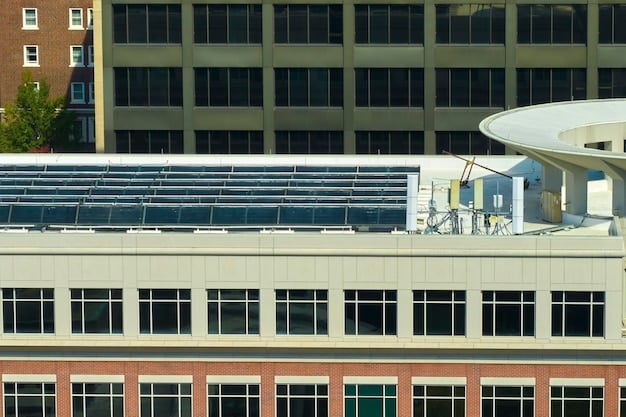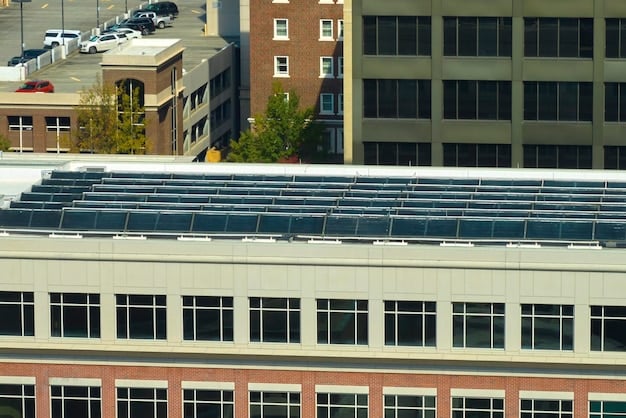Navigate Energy Prices in 2025: Save on Business Costs

Energy Prices in 2025: How to Reduce Your Business’s Energy Consumption and Costs: Businesses can mitigate rising energy costs by investing in energy-efficient technologies, conducting regular energy audits, implementing employee training programs, and exploring renewable energy sources to reduce consumption and operational expenses.
Facing rising energy costs in 2025? Don’t let them impact your bottom line. This guide provides actionable strategies to reduce your business’s energy consumption and cut costs.
Understanding the 2025 Energy Price Landscape
The global energy market is constantly evolving, and 2025 is poised to be another year of significant changes. Businesses need to understand the factors driving energy prices to make informed decisions.
Several factors are contributing to this dynamic landscape. These include geopolitical tensions, the increasing demand for energy from developing economies, and the transition to renewable energy sources.
Key Factors Influencing Energy Prices
Understanding these influences is essential for businesses to anticipate and adapt to energy price fluctuations.
- Geopolitical Instability: Conflicts and political instability in key energy-producing regions can disrupt supply chains, leading to price spikes.
- Economic Growth: As economies grow, so does their demand for energy, which can put upward pressure on prices.
- Renewable Energy Transition: The shift towards renewable energy sources like solar and wind can impact traditional energy markets and pricing.
These factors create a complex interplay that businesses must navigate to manage their energy costs effectively.
In 2025, taking a proactive and informed approach to energy management is more crucial than ever for businesses looking to maintain profitability and sustainability.
Conducting an Energy Audit for Your Business
An energy audit is the first step in understanding how your business consumes energy. It identifies areas of waste and inefficiency, providing a roadmap for improvement.
Professional energy auditors can conduct a thorough assessment of your facility, equipment, and energy usage patterns.

Why Conduct an Energy Audit?
An energy audit provides valuable insights into your energy consumption, enabling you to make informed decisions and implement targeted energy-saving measures.
An audit can help you identify:
- Inefficient Equipment: Older or poorly maintained equipment can consume significantly more energy than newer, more efficient models.
- Building Envelope Issues: Leaks in windows, doors, and insulation can lead to energy loss and increased heating and cooling costs.
- Lighting Inefficiencies: Outdated lighting systems can consume excessive energy.
Regular energy audits are essential for businesses to stay on top of their energy consumption and identify new opportunities for savings.
By implementing the changes recommended in an energy audit, businesses can significantly reduce their energy costs and improve their environmental footprint
Investing in Energy-Efficient Technologies
Upgrading to energy-efficient technologies can significantly reduce your business’s energy consumption. These technologies often have a higher upfront cost but offer long-term savings.
From lighting to HVAC systems, there are numerous energy-efficient options available for businesses.
Switching to LED lighting is a simple and effective way to reduce energy consumption. LEDs use significantly less energy and last much longer than traditional incandescent or fluorescent bulbs.
Energy-Efficient HVAC Systems
Heating, ventilation, and air conditioning (HVAC) systems are major energy consumers in many businesses. Upgrading to a more efficient HVAC system can result in substantial savings.
- Smart Thermostats: Programmable thermostats can adjust temperature settings based on occupancy and time of day, reducing wasted energy.
- High-Efficiency Furnaces and Air Conditioners: Look for models with high Seasonal Energy Efficiency Ratio (SEER) and Annual Fuel Utilization Efficiency (AFUE) ratings.
- Regular Maintenance: Properly maintained HVAC systems operate more efficiently and have a longer lifespan.
These HVAC solutions can significantly reduce energy costs while maintaining a comfortable environment for employees and customers.
Investing in energy-efficient technologies is a smart move for businesses looking to reduce their energy consumption and improve their bottom line.
Exploring Renewable Energy Sources
Renewable energy sources like solar, wind, and geothermal can provide a clean and cost-effective alternative to traditional energy sources. Businesses can explore these options to reduce their reliance on fossil fuels and lower their energy costs.
Solar energy is one of the most accessible and widely used renewable energy sources for businesses.

Benefits of Renewable Energy
Transitioning to renewable energy offers numerous benefits for businesses, including cost savings, environmental responsibility, and enhanced brand image.
Here are several key advantages:
- Reduced Energy Costs: Renewable energy sources like solar and wind can significantly lower your electricity bills.
- Environmental Sustainability: Using renewable energy reduces your carbon footprint and helps combat climate change.
- Tax Incentives and Rebates: Many government programs offer financial incentives for businesses that invest in renewable energy.
By embracing renewable energy, businesses can contribute to a more sustainable future while also improving their financial performance.
Investing in renewable energy is a forward-thinking strategy for businesses aiming to reduce their energy consumption and demonstrate their commitment to environmental stewardship.
Implementing Employee Training Programs
Engaging employees in energy-saving initiatives can have a significant impact on your business’s energy consumption. Training programs can educate employees about energy-saving practices and encourage them to adopt these habits both at work and at home.
By empowering employees to be energy conscious, businesses can create a culture of sustainability.
Effective Training Strategies
Successful training programs incorporate a variety of strategies to engage employees and reinforce energy-saving behaviors.
Consider these recommendations:
- Interactive Workshops: Hands-on workshops can provide practical tips and techniques for saving energy in the workplace.
- Incentive Programs: Reward employees who actively participate in energy-saving initiatives.
- Regular Communication: Keep employees informed about the latest energy-saving tips and progress updates.
These strategies can help foster a culture of energy conservation within your organization.
A well-designed employee training program can empower your workforce to become active participants in your business’s energy-saving efforts.
Optimizing Building Design and Layout
The design and layout of your building can have a significant impact on its energy efficiency. Businesses can optimize their building design to reduce energy consumption and improve indoor environmental quality.
Simple changes like proper insulation and window placement can lead to substantial energy savings.
Strategies for Building Optimization
Building optimization involves a range of strategies, from simple modifications to more extensive renovations.
Here are some key considerations:
- Natural Lighting: Maximize the use of natural light to reduce the need for artificial lighting.
- Insulation: Ensure adequate insulation in walls, roofs, and floors to minimize heat loss and gain.
- Window Placement: Strategically position windows to optimize natural light and ventilation while minimizing solar heat gain.
These strategies can help create a more energy-efficient and comfortable work environment.
Optimizing building design and layout is an effective way for businesses to reduce their energy consumption and improve their overall sustainability.
| Key Point | Brief Description |
|---|---|
| 💡 Energy Audit | Identifies energy waste areas and provides an improvement roadmap. |
| ⚡ Efficient Tech | Upgrade to energy-saving technologies for long-term savings. |
| ☀️ Renewable Sources | Explore solar, wind, and geothermal options for cost-effective energy. |
| 👩💼 Employee Training | Educate employees on energy-saving practices. |
FAQ
▼
Geopolitical tensions, economic growth in developing countries, and the transition to renewable energy sources are key factors.
▼
It is recommended to conduct a comprehensive energy audit every 1-3 years to identify new areas for improvement.
▼
LED lighting, smart thermostats, and high-efficiency HVAC systems are highly effective and provide a solid return on investment.
▼
Yes, many government programs offer tax credits, rebates, and grants for businesses that invest in renewable energy sources.
▼
Training programs educate employees about energy-saving practices, fostering a culture of sustainability within the workplace and at home.
Conclusion
Navigating the energy price landscape in 2025 requires businesses to adopt proactive and strategic approaches. By conducting thorough energy audits, investing in energy-efficient technologies, exploring renewable energy sources, implementing employee training programs, and optimizing building design, companies can effectively reduce their energy consumption and costs, ensuring a sustainable and profitable future.





